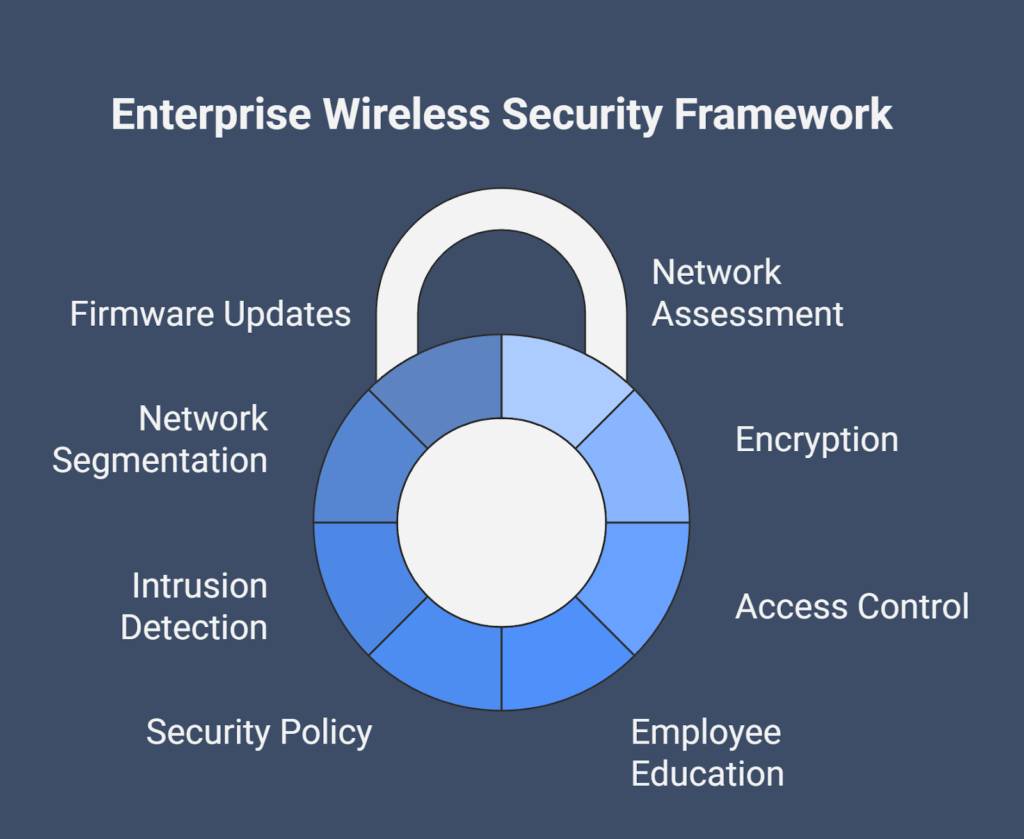Table of Contents
What is Enterprise Wireless Security?
Enterprise wireless security refers to the comprehensive framework of technologies, policies, and operational practices designed to secure an organization’s entire wireless communication ecosystem. It includes not just Wi-Fi, but also Bluetooth, Bluetooth Low Energy (BLE), cellular devices, and a diverse range of IoT protocols.
Wireless connectivity supports a wide variety of devices fundamental to enterprise productivity, from laptops and smartphones to smart sensors and mobile IoT devices. Securing these diverse protocols is essential, as attackers increasingly exploit vulnerabilities beyond traditional Wi-Fi networks.
An effective wireless security architecture safeguards the confidentiality, integrity, and availability of wireless communications. It mitigates risks across protocols commonly found in the enterprise environment, maintaining data protection and regulatory compliance while enabling operational agility.
Learn more about Wireless Intrusion Detection System (WIDS) solutions.

The Critical Importance of Enterprise Wireless Security
Wireless networks are uniquely vulnerable because their signals propagate through the air, accessible within proximity limits. As wireless device adoption has surged, so has the size and complexity of the wireless attack surface.
The consequences of poor wireless security include:
- Financial Losses: Regulatory fines, legal costs, incident recovery expenses, and lost revenue from operational disruption accumulate rapidly following wireless breaches.
- Data Exfiltration and Intellectual Property Risks: Sensitive information, trade secrets, and personal data traversing wireless networks are prime targets for threat actors.
- Operational Downtime: Wireless disruptions due to jamming or denial-of-service attacks impair business functions and customer experience.
- Compliance Failures: Enterprises must meet regulatory standards, including GDPR, HIPAA, PCI DSS, NIST SP 800-53, CNSSI 1253, and RMF, which increasingly mandate robust wireless security controls.
Proactively addressing wireless risks is no longer optional but a business imperative for sustaining trust and compliance.
Common Wireless Security Threats in 2025
Rogue Access Points
Unauthorized access points, whether maliciously installed by attackers or unintentionally introduced by employees, pose a significant risk. These devices connect to the corporate network without the knowledge or approval of security teams, creating backdoors that bypass perimeter defenses. Rogue APs enable attackers to capture data, launch man-in-the-middle attacks, and move laterally within the network.
Evil Twin Attacks
This attack involves the deployment of a fraudulent wireless access point configured to mimic a legitimate network’s SSID. Unsuspecting users connect to the evil twin, exposing their data to interception. Attackers exploit this trust to harvest credentials, hijack sessions, and inject malicious payloads.
Wireless Packet Sniffing
Passive capture of wireless traffic remains a persistent threat. Attackers with sniffing tools intercept data over the airwaves, particularly on networks with weak or outdated encryption. It can lead to the compromise of passwords, financial details, and confidential communications.
Bluetooth and BLE Attacks
Bluetooth and BLE, especially in IoT devices and peripherals, are vulnerable to exploitation. Weak pairing, insufficient authentication, and poor encryption make them prime targets. Exploits can result in device control, data theft, malware propagation, and network entry points.
IoT Device Exploits
IoT deployments often lack rigorous security. Default credentials, poor authentication, and unpatched firmware make devices easy targets. Attackers exploit these flaws to access networks, exfiltrate data, or disrupt operational technology systems.
Denial-of-Service (DoS)
Wireless networks are susceptible to DoS attacks such as frequency jamming or flooding. By overwhelming wireless spectrum with noise or illegitimate traffic, attackers degrade or halt communications. Such disruptions impact operations and may mask more covert attacks.
Outdated Encryption Protocols
Despite known vulnerabilities, some enterprises still rely on deprecated protocols like WEP and WPA, particularly for compatibility with older devices that do not support newer standards. These are easy to exploit. Transitioning to WPA3 is critical to eliminate these gaps.
A layered defense that includes monitoring, detection, and rapid response is essential.
Developing and Enforcing a Robust Enterprise Wireless Security Policy
A clear, comprehensive wireless security policy is foundational for enterprise defense. It must:
- Define allowed wireless protocols and device types.
- Require unique credentials per device or user using 802.1X or equivalent models.
- Specify requirements for encryption standards (e.g., WPA3 for Wi-Fi, secure Bluetooth pairing).
- Implement segmentation strategies to identify and isolate critical assets.
- Outline employee responsibilities and acceptable use guidelines.
- Establish incident reporting and response procedures.
Policy enforcement relies on continuous communication, training, and technological controls confirming compliance.
Implementing a Multi-Protocol Wireless Intrusion Detection System (WIDS)
WIDS is a crucial security layer that provides continuous real-time monitoring and threat detection across Wi-Fi, Bluetooth, BLE, Cellular, and IoT protocols.
Key WIDS Capabilities
- Broad spectrum coverage capturing all potential wireless attack vectors.
- Multi-layer detection combining signature, anomaly, and behavioral analytics for superior accuracy.
- Device localization pinpointing physical locations of suspicious devices for targeted remediation.
- Seamless integration with SIEM, SOAR, and other security controls, enabling unified workflows.
In a typical example, a government site detected an unauthorized Bluetooth device transmitting anomalous signals. Incident responders used localization data to neutralize the threat swiftly, maintaining compliance mandates.
Training and Cultivating a Wireless Security Culture
Technical controls alone are insufficient without informed users. Enterprises should:
- Provide regular training on threats across wireless protocols.
- Educate on safe wireless device use, recognizing social engineering and phishing tactics.
- Promote policies discouraging unauthorized personal hotspots and rogue devices.
- Encourage reporting of unusual network behavior.
A security-aware culture dramatically lowers the risk of inadvertent wireless misconfiguration or compromise.
Wireless Network Segmentation Strategies
To limit exposure, enterprise security strategies should include both logical and physical segmentation of networks:
- Separate guest and corporate Wi-Fi networks.
- Isolate IoT and BLE device traffic to reduce lateral attack pathways.
- Designate restricted zones for cellular-connected devices.
- Utilize VLAN tagging, access control lists, and enforce inter-zone monitoring.
The goal is to contain potential breaches and preserve critical business assets.
Regular Firmware and Software Update Management
Keeping wireless hardware and software updated is vital. Best practices include:
- Including wireless as part of the vulnerability management system.
- Establishing a patch management schedule to apply vendor updates promptly.
- Automating update rollouts to minimize human error and lag.
- Testing updates in pilot environments before network-wide deployment.
Proactive patching closes vulnerabilities before exploitation occurs.
Integrating Wireless Security with Security Operations Centers and Automation
Modern wireless security does not operate in isolation. Integration with enterprise Security Operations Centers (SOCs) and security automation platforms enables:
- Correlation of wireless alerts with physical security, endpoint, and network data.
- Automated prioritization and orchestration of threat response.
- Enhanced incident management across multiple security domains.
Integrated operations improve situational awareness and reduce incident resolution times.
Comparing Legacy Wi-Fi Solutions and Next-Generation Multi-Protocol WIDS
Legacy WIDS focus on Wi-Fi traffic with limited ability to detect threats from Bluetooth, cellular, or IoT sources. In contrast, next-generation WIDS solutions offer greater capabilities for a stronger security posture:
| Feature | Legacy Wi-Fi WIDS | Next-Gen Multi-Protocol WIDS |
| Protocol Coverage | Only Wi-Fi | Wi-Fi, Bluetooth, BLE, Cellular, IoT, and other wireless protocols |
| Device Localization | Limited | Precise location capabilities |
| Threat Detection Techniques | Mostly signature-based | Signature + Anomaly + Behavioral |
| Integration with SOC/SIEM and other security controls | Basic or limited | Extensive and automated |
| Compliance Support | Partial | Extensive alignment to diverse frameworks |
Enterprises require next-gen WIDS solutions as a core component of Enterprise Wireless Security, maintaining protection across all facets of the wireless environment.
Preparing for Future Wireless Security Regulatory Requirements
Regulatory landscapes continuously evolve, with increasing focus on wireless attack surfaces. Anticipate and prepare by:
- Consulting updated NIST, CNSSI, HIPAA, PCI DSS, and GDPR mandates.
- Building compliance-centric security programs with auditable logs.
- Engaging third-party expertise or certification to validate programs.
Proactive compliance supports business continuity and helps avoid sanctions.
Building an Effective Audit Program
A formal audit program should incorporate the following elements for thorough coverage and continuous improvement:
- Comprehensive asset discovery across wireless protocols commonly found in the enterprise environment to identify authorized and unauthorized devices.
- Policy compliance validation against organizational standards, frameworks, and regulatory requirements.
- Detailed review of wireless traffic and alerts, including anomaly detection and correlation with incident logs.
- Incident response effectiveness assessment to evaluate detection speed, containment, and remediation actions.
- Documentation and reporting to provide clear visibility for executives, regulators, and auditors.
- Continuous improvement cycles, to help translate lessons learned into updated controls and a stronger security posture.
Audits not only support continuous improvements and regulatory alignment but also strengthen resilience and demonstrate accountability across the enterprise.
Frequently Asked Questions (FAQs)
What sets modern wireless security apart from past approaches?
Modern WIDS solutions come with multi-protocol monitoring, including Bluetooth, Cellular, IoT, and other protocols beyond Wi-Fi, coupled with advanced detection and localization.
How does segmentation help?
Network segmentation isolates device groups, contains threats, limits the spread of an intrusion, and improves the network’s security posture.
How often should wireless systems be updated?
Organizations should promptly test, validate, and apply patches when they become available, based on the policies and procedures of the patch management team..
Can WIDS integrate with existing tools?
Yes. Modern WIDS offers APIs and connectors that integrate with SIEMs, SOAR platforms, physical security controls, and other security operation tools, further strengthening security.
Is employee training necessary?
Yes. Employee actions increasingly impact wireless security effectiveness.
Strategic Next Steps for Enterprise Wireless Security
- Conduct an inclusive multi-protocol wireless asset and vulnerability assessment.
- Develop and enforce comprehensive wireless policies covering all device and protocol categories.
- Implement a multi-layer defense combining strong encryption, authentication, segmentation, and advanced WIDS.
- Maintain constant firmware management and proactive patching policies.
- Invest in staff training specific to security challenges and incident response.
- Integrate operations with enterprise SOC and automation for rapid, coordinated threat reaction.
- Regularly audit wireless security posture and adapt to regulatory updates and emerging threats.
Partnering with industry leaders like Bastille supports the deployment of cutting-edge wireless intrusion detection solutions that safeguard business-critical data and maintain compliance in complex enterprise environments.



